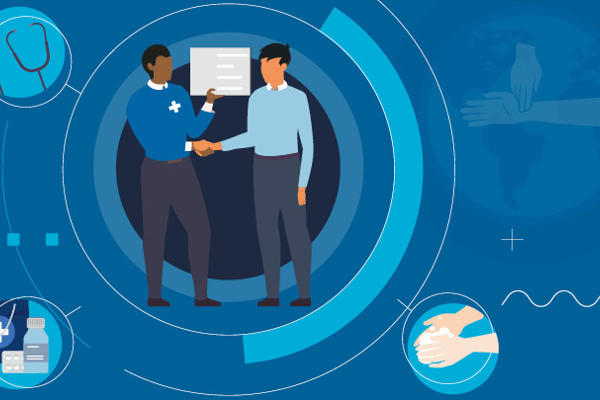The National Early Warning Score: Communication across the system from West of England AHSN
NEWS2 is the latest version of the National Early Warning Score (NEWS), first produced in 2012 and updated in December 2017, which advocates a system to standardise the assessment and response to acute illness.
How NEWS works
The NEWS is based on a simple aggregate scoring system in which a score is allocated to physiological measurements, already recorded in routine practice, when patients present to, or are being monitored in hospital. Six simple physiological parameters form the basis of the scoring system:
- respiration rate
- oxygen saturation
- systolic blood pressure
- pulse rate
- level of consciousness or new confusion*
- temperature.
*The patient has new-onset confusion, disorientation and/or agitation, where previously their mental state was normal – this may be subtle. The patient may respond to questions coherently, but there is some confusion, disorientation and/or agitation. This would score 3 or 4 on the GCS (rather than the normal 5 for verbal response), and scores 3 on the NEWS system.
A score is allocated to each parameter as they are measured, with the magnitude of the score reflecting how extremely the parameter varies from the norm. The score is then aggregated and uplifted by 2 points for people requiring supplemental oxygen to maintain their recommended oxygen saturation.
This is a pragmatic approach, with a key emphasis on system-wide standardisation and the use of physiological parameters that are already routinely measured in NHS hospitals and in prehospital care, recorded on a standardised clinical chart – the NEWS2 chart.
NEWS2 has continued to be evaluated in acute care setting as demonstrated in these papers:
NEWS2 has received formal endorsement from NHS England and NHS Improvement to become the early warning system for identifying acutely ill patients – including those with sepsis – in hospitals in England.
The NEWS2 Report
- NEWS2 Executive summary 512.83 KB
- NEWS2 Final report 2.47 MB
- NEWS2 Chart 1_The NEWS scoring system 172.7 KB
- NEWS2 Chart 2_NEWS thresholds and triggers 97.96 KB
- NEWS2 Chart 3_NEWS observation chart 616.11 KB
- NEWS2 Chart 4_Clinical response to NEWS trigger thresholds 153.12 KB
Supplementary guidance to support implementation of NEWS 2
The RCP has also produced supplementary guidance to support implementation of NEWS2. Advice is given in five categories – new confusion, escalation/response guidance, oxygen scales, receiving acute patients into hospital, and what to do when the NEWS2 scores are incomplete.
An example of a structured document of clinical response to deterioration can be found here.
NEWS2 and deterioration in COVID-19
This guidance emphasises the place of NEWS2 in managing patients with COVID-19.
NEWS2 should be used when managing patients with COVID 19. The use of NEWS2 will ensure that patients who are deteriorating, or at risk of deteriorating, will have a timely initial assessment by a competent clinical decision maker. NEWS2 should supplement clinical judgement in assessing the patient’s condition.
The NEWS2 scoring system for oxygen supplementation is binary (yes/no). In patients with COVID-19 infection, once hospitalised and treated with oxygen, their oxygen requirement might increase rapidly if their respiratory function deteriorates but this may not result in any additional significant increase in the NEWS2 score. Therefore, in patients with COVID 19, all staff should be aware that ANY increase in oxygen requirements should trigger an escalation call to a competent clinical decision maker. This should be accompanied by an initial increase in observations to at least hourly until a clinical review happens, if this has not already happened as a result of NEWS2.
Use of NEWS2 across the acute care pathway
NEWS2 is increasingly used across the acute care pathway and this is demonstrated in the video below which tells Paul's story - an example of NEWS enabling swift and effective treatment.
Evaluating local effectiveness of NEWS2
NEWS2 aims to ensure a rapid response to the deteriorating patient. Internal guidance on measuring the effective implementation locally is given in this paper by the International Society for Rapid Response systems.
NEWS2 focus in Clinical Medicine
Professor Bryan Williams, chair of the guideline development groups for NEWS and NEWS2, has curated a special issue of Clinical Medicine (November 2022) focusing on NEWS2. Contributions from those at the forefront of developing, assessing, implementing and using the score give an all-round insight into its impact over the past 10 years and its future as a crucial element in safe care across the NHS:
- The National Early Warning Score: from concept to NHS implementation.
- NEWS and the NHS.
- Using NEWS2: an essential component of reliable clinical assessment.
- NEWS2 and improving outcomes from sepsis.
- NEWS2, patient safety and hypercapnic respiratory failure.
- NEWS2 and the older person.
- NEWS2 in out-of-hospital settings: the ambulance and the emergency department.
- The development and introduction of a national e-learning programme to support the dissemination of NEWS2.
- Digital NEWS? How to amplify the benefits of NEWS in a digital health care system.
- Evaluation of the utility of NEWS2 during the COVID-19 pandemic.
Contact
- For England implementation and clinical queries: cqid@rcp.ac.uk
- Other nations and international queries about NEWS2: cqid@rcp.ac.uk
- For Issues relating to the e-learning tool: support@news2.org.uk
- For queries on RCP work in QI and Patient Safety relating to NEWS2: cqid@rcp.ac.uk
Accessing the original NEWS report (2012)
The original NEWS (2012) report is available to download.
Please note that the report is archived and for research purposes only. It should not be used under any circumstances in clinical practice.
NEWS2 and copyright
In order to encourage as many people as possible to use the material there is no copyright restriction on NEWS2. You are therefore free to reproduce material, as long as you meet the following conditions:
- The RCP should be acknowledged as follows:
Reproduced from: Royal College of Physicians. National Early Warning Score (NEWS) 2: Standardising the assessment of acute-illness severity in the NHS. Updated report of a working party. London: RCP, 2017. - The material must not be modified/amended in any way.
- The NEWS2 charts must be reproduced in colour.
- Do not use the low-quality version of the charts in the report itself but instead download the high-quality versions as linked below.
- Please include the following disclaimer on any translated material:
The wording of this translation has not been specifically approved by the Royal College of Physicians – please refer to the English language version before making any clinical use of this information.





